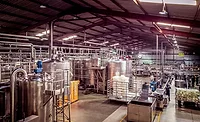The False Security of the CFU in Environmental Monitoring Programs
In this article, we’ll take a fresh look at microbiological testing, particularly the colony-forming unit (CFU), as part of an environmental monitoring program. Since the pioneering days of Louis Pasteur and Robert Koch (mid-1800s), the gold standard for microbiology testing has been the culture method, the principles of which have remained largely unchanged. Professional opinion acknowledges that the CFU is defined as “at best, an estimate and should not be reported as absolute.” (From Compendium of Methods for the Microbiological Examination of Foods, 1992.)
The CFU is fundamentally flawed by the incorrect assumption that a single colony is derived from a single bacterium. Each replicate will yield a result with a different colony count. Several replicates for different dilutions of each sample are required to obtain a reasonable approximation, but this is seldom done in routine testing. Even in the best-run laboratories, the uncertainty of measurement can be ± 40%. This means that the actual value is not known for certain, and for a sample expected to contain 10,000 CFU, the true value lies somewhere within the range of 6,000 to 14,000 on 95% of occasions but can also be outside this range 5% of the time. Plate counts should have a minimum of 25 colonies to give a reasonable probability of enumeration. As the number of colonies per plate decreases, the standard error of the result increases to 50% for five colonies and 100% for one colony, so the enumeration in the range of 1–10 colonies per plate is very unreliable. In an environmental sampling program, the closer the environmental sample test location is to a food contact surface, the tighter the specification. Low sample numbers and the use of single replicates generate poor-quality data that are mistakenly considered to be absolute, reliable and definitive.
All of the above drives the questions: What information do we require, how can we achieve it and what are reasonable expectations within the limits of existing or alternative methods?
The Challenge of Validating Alternative Methods
Several alternative and rapid methods exist, yet their adoption has been limited by the requirement to validate their performance against culture plate count methods, creating a problem for validation due to the variability of enumeration from the CFU. Validation studies for surface contamination typically use factorial design, where 20 replicates are used and the percentage of positive samples are recorded, not the number of colonies. In an environmental program, most samples yield results of 1–10 colonies or fewer. The enumeration has a high inherent variability and begs the question as to the value of the information generated. Trying to enumerate with fewer than 25 colonies on a plate gives a meaningless result that should be considered semiquantitative at best. Certification bodies typically compare methods over a 3-log cycle within a range of 1,000 to 10 million CFU/g foodstuff and define equivalence as less than a 0.5-log CFU difference. Validation of enumeration methods for environmental samples is much more difficult, because the samples contain fewer organisms and the variation from all sources above is even greater. You can get a better understanding of surface contamination and risk if you change the perspective and the yardstick.
A Fresh Look at Microbiology Test Results
Since the CFU is highly variable, it may be unreasonable to seek correlation but better to seek a more meaningful metric such as microbial activity. Expressing results within ranges of time to detection and ranges of CFU using a statistical binning technique is a more pragmatic and meaningful way to compare two variable methods. This is particularly useful at low contamination levels and a narrow dynamic range, such as in environmental samples for cleaning verification. Grouping contamination levels as bands (or in bins) is a more statistically relevant approach that yields a better representation and correlation of low numbers of microorganisms on surfaces. Under these circumstances, the concept of pass/caution/fail is more meaningful and easier to understand where pass is less than X and fail is greater than Y. This smooths out the variation due to sample distribution and within the method itself to improve the correlation from less than 60% to greater than 90% and provides a greater confidence in the results.
An ideal solution would be a detection system that collected a representative sample to allow maximum recovery from the surface without losses due to resuspension, dilution or time to initiate the test, and delivered results in the shortest possible time for trend analysis. This can be achieved if the sample collection device is also the detection device. As with all modern rapid methods relying on metabolic activity, the challenge is how to compare these different approaches to the colony count method, particularly at very low contamination levels.
It is time to accept the limitations of plate counts and the CFU and to seek a more meaningful metric for data analysis of microbial contamination. Adenosine triphosphate surface testing for product residues has changed the way that cleaning is monitored and verified, and it is now widely accepted. Surely we can adopt a similar approach for measuring microbial activity and contamination with existing and alternative methods.
Looking for quick answers on food safety topics?
Try Ask FSM, our new smart AI search tool.
Ask FSM →







